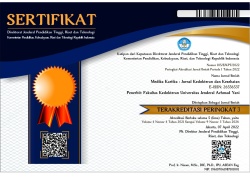PELUANG PENGEMBANGAN ARTIFICIAL INTELLIGENCE PADA RADIOTERAPI DI INDONESIA
Abstract
Teknologi radioterapi berkembang dengan pesat seiring dengan pemanfaatan artificial intelligence pada setiap tahapan-tahapan radioterapi, sehingga diharapkan dapat meningkatkan kualitas pelayanan dan kesuksesan dalam melaksanakan radioterapi. Indonesia merupakan negara yang sangat berpeluang untuk mengembangkan radioterapi untuk mengurangi risiko kematian masyarakat yang diakibatkan oleh kanker. Pada artikel ini disampaikan penelitian-penelitian terkait pendekatan artificial intelligence yang diintegrasikan pada tahapan diagnostik, pengkonturan, perencanaan, treatment, quality assurance, dan prediksi hasil pada radioterapi. Sehingga penelitian-penelitian tersebut dapat dikembangkan dan diimplementasikan pada fasilitas radioterapi di Indonesia.
Kata kunci: artificial intelligence, radioterapi, segmentasi, treatment planning system
DOI : 10.35990/mk.v6n4.p430-441
References
2. Tran GS, Nghiem TP, Nguyen VT, Luong CM, Burie JC. Improving Accuracy of Lung Nodule Classification Using Deep Learning with Focal Loss. J Healthc Eng. 2019 Feb 4;2019:1–9.
3. Sung H, Ferlay J, Siegel RL, Laversanne M, Soerjomataram I, Jemal A, et al. Global Cancer Statistics 2020: GLOBOCAN Estimates of Incidence and Mortality Worldwide for 36 Cancers in 185 Countries. CA Cancer J Clin. 2021 May;71(3):209–49.
4. Perhimpunan Dokter Spesialis Onkologi Radiasi Indonesia (PORI). Program Kerja Perhimpunan Dokter Spesialis Onkologi Radiasi Indonesia 2018-2020. 13th ed. 2018.
5. van den Berg CAT, Meliadò EF. Uncertainty Assessment for Deep Learning Radiotherapy Applications. Semin Radiat Oncol. 2022 Oct;32(4):304–18.
6. Jabbarpour A, Mahdavi SR, Vafaei Sadr A, Esmaili G, Shiri I, Zaidi H. Unsupervised pseudo CT generation using heterogenous multicentric CT/MR images and CycleGAN: Dosimetric assessment for 3D conformal radiotherapy. Comput Biol Med. 2022 Apr;143:105277.
7. Emami H, Dong M, Nejad‐Davarani SP, Glide‐Hurst CK. Generating synthetic CTs from magnetic resonance images using generative adversarial networks. Med Phys. 2018 Aug;45(8):3627–36.
8. Edmund JM, Nyholm T. A review of substitute CT generation for MRI-only radiation therapy. Radiat Oncol. 2017 Dec;12(1):28.
9. Ulin K, Urie MM, Cherlow JM. Results of a Multi-Institutional Benchmark Test for Cranial CT/MR Image Registration. Int J Radiat Oncol. 2010 Aug;77(5):1584–9.
10. Roberson PL, McLaughlin PW, Narayana V, Troyer S, Hixson GV, Kessler ML. Use and uncertainties of mutual information for computed tomography/magnetic resonance (CT/MR) registration post permanent implant of the prostate: Mutual information for CT/MR registration of the prostate. Med Phys. 2005 Jan 26;32(2):473–82.
11. Dean CJ, Sykes JR, Cooper RA, Hatfield P, Carey B, Swift S, et al. An evaluation of four CT–MRI co-registration techniques for radiotherapy treatment planning of prone rectal cancer patients. Br J Radiol. 2012 Jan;85(1009):61–8.
12. Putri PA, Taurisia R, Pawiro SA. Estimasi Dosis Radiasi pada Perlakuan Cone Beam CT Radioterapi. :4.
13. Boulanger M, Nunes JC, Chourak H, Largent A, Tahri S, Acosta O, et al. Deep learning methods to generate synthetic CT from MRI in radiotherapy: A literature review. Phys Med. 2021 Sep;89:265–81.
14. Lerner M, Medin J, Jamtheim Gustafsson C, Alkner S, Siversson C, Olsson LE. Clinical validation of a commercially available deep learning software for synthetic CT generation for brain. Radiat Oncol. 2021 Dec;16(1):66.
15. Palmér E, Karlsson A, Nordström F, Petruson K, Siversson C, Ljungberg M, et al. Synthetic computed tomography data allows for accurate absorbed dose calculations in a magnetic resonance imaging only workflow for head and neck radiotherapy. Phys Imaging Radiat Oncol. 2021 Jan;17:36–42.
16. Ma X, Chen X, Wang Y, Qin S, Yan X, Cao Y, et al. Personalized Modeling to Improve Pseudo–Computed Tomography Images for Magnetic Resonance Imaging–Guided Adaptive Radiation Therapy. Int J Radiat Oncol. 2022 Jul;113(4):885–92.
17. Rigaud B, Simon A, Castelli J, Lafond C, Acosta O, Haigron P, et al. Deformable image registration for radiation therapy: principle, methods, applications and evaluation. Acta Oncol. 2019 Sep 2;58(9):1225–37.
18. Archambault Y, Boylan C, Bullock D, Morgas T, Peltola J, Emmi R, et al. Making Online Adaptive Radiotherapy Possible using Artificial Intelligence and Machine Learning for Efficient Daily Replanning. Med Phys Int. 2020;8.
19. Sibolt P, Andersson LM, Calmels L, Sjöström D, Bjelkengren U, Geertsen P, et al. Clinical implementation of artificial intelligence-driven cone-beam computed tomography-guided online adaptive radiotherapy in the pelvic region. Phys Imaging Radiat Oncol. 2021 Jan;17:1–7.
20. Bai X, Wang B, Wang S, Wu Z, Gou C, Hou Q. Radiotherapy dose distribution prediction for breast cancer using deformable image registration. Biomed Eng OnLine. 2020 Dec;19(1):39.
21. Ahn SH, Yeo AU, Kim KH, Kim C, Goh Y, Cho S, et al. Comparative clinical evaluation of atlas and deep-learning-based auto-segmentation of organ structures in liver cancer. Radiat Oncol. 2019 Dec;14(1):213.
22. La Macchia M, Fellin F, Amichetti M, Cianchetti M, Gianolini S, Paola V, et al. Systematic evaluation of three different commercial software solutions for automatic segmentation for adaptive therapy in head-and-neck, prostate and pleural cancer. Radiat Oncol. 2012 Dec;7(1):160.
23. Lustberg T, van Soest J, Gooding M, Peressutti D, Aljabar P, van der Stoep J, et al. Clinical evaluation of atlas and deep learning based automatic contouring for lung cancer. Radiother Oncol. 2018 Feb;126(2):312–7.
24. Liu Z, Chen W, Guan H, Zhen H, Shen J, Liu X, et al. An Adversarial Deep-Learning-Based Model for Cervical Cancer CTV Segmentation With Multicenter Blinded Randomized Controlled Validation. Front Oncol. 2021 Aug 19;11:702270.
25. Wang J, Chen Z, Yang C, Qu B, Ma L, Fan W, et al. Evaluation Exploration of Atlas-Based and Deep Learning-Based Automatic Contouring for Nasopharyngeal Carcinoma. Front Oncol. 2022 Mar 31;12:833816.
26. Bi N, Wang J, Zhang T, Chen X, Xia W, Miao J, et al. Deep Learning Improved Clinical Target Volume Contouring Quality and Efficiency for Postoperative Radiation Therapy in Non-small Cell Lung Cancer. Front Oncol. 2019 Nov 13;9:1192.
27. Ronneberger O, Fischer P, Brox T. U-Net: Convolutional Networks for Biomedical Image Segmentation. In: Navab N, Hornegger J, Wells WM, Frangi AF, editors. Medical Image Computing and Computer-Assisted Intervention – MICCAI 2015 [Internet]. Cham: Springer International Publishing; 2015 [cited 2022 Oct 31]. p. 234–41. (Lecture Notes in Computer Science; vol. 9351). Available from: http://link.springer.com/10.1007/978-3-319-24574-4_28
28. He K, Zhang X, Ren S, Sun J. Deep Residual Learning for Image Recognition. In: 2016 IEEE Conference on Computer Vision and Pattern Recognition (CVPR) [Internet]. Las Vegas, NV, USA: IEEE; 2016 [cited 2022 Oct 31]. p. 770–8. Available from: http://ieeexplore.ieee.org/document/7780459/
29. Craft D, McQuaid D, Wala J, Chen W, Salari E, Bortfeld T. Multicriteria VMAT optimization: Multicriteria VMAT optimization. Med Phys. 2012 Jan 12;39(2):686–96.
30. Breedveld S, Storchi PRM, Voet PWJ, Heijmen BJM. iCycle: Integrated, multicriterial beam angle, and profile optimization for generation of coplanar and noncoplanar IMRT plans: iCycle: multicriteria beam angle optimization. Med Phys. 2012 Jan 31;39(2):951–63.
31. Ge Y, Wu QJ. Knowledge‐based planning for intensity‐modulated radiation therapy: A review of data‐driven approaches. Med Phys. 2019 Jun;46(6):2760–75.
32. Zhu X, Ge Y, Li T, Thongphiew D, Yin FF, Wu QJ. A planning quality evaluation tool for prostate adaptive IMRT based on machine learning: Planning quality evaluation tool for adaptive radiotherapy. Med Phys. 2011 Jan 11;38(2):719–26.
33. Chanyavanich V, Das SK, Lee WR, Lo JY. Knowledge-based IMRT treatment planning for prostate cancer: Knowledge-based IMRT treatment planning for prostate cancer. Med Phys. 2011 May 2;38(5):2515–22.
34. El Naqa I, Irrer J, Ritter TA, DeMarco J, Al‐Hallaq H, Booth J, et al. Machine learning for automated quality assurance in radiotherapy: A proof of principle using EPID data description. Med Phys. 2019 Apr;46(4):1914–21.
35. El Naqa I. Biomedical informatics and panomics for evidence-based radiation therapy. Wiley Interdiscip Rev Data Min Knowl Discov. 2014 Jul;4(4):327–40.
36. Wang B, Li R, Perrizo W, editors. Heuristic Principal Component Analysis-Based Unsupervised Feature Extraction and Its Application to Bioinformatics [Internet]. IGI Global; 2015 [cited 2022 Nov 1]. (Azar AT, editor. Advances in Bioinformatics and Biomedical Engineering). Available from: http://services.igi-global.com/resolvedoi/resolve.aspx?doi=10.4018/978-1-4666-6611-5
37. Naqa I, R L, MJ M. Machine learning in radiation oncology: theory and Applications. Switzerland: Springer International Publishing; 2015.
38. Langen KM, Papanikolaou N, Balog J, Crilly R, Followill D, Goddu SM, et al. QA for helical tomotherapy: Report of the AAPM Task Group 148a): TG-148. Med Phys. 2010 Aug 20;37(9):4817–53.
39. Arjomandy B, Taylor P, Ainsley C, Safai S, Sahoo N, Pankuch M, et al. AAPM task group 224: Comprehensive proton therapy machine quality assurance. Med Phys [Internet]. 2019 Aug [cited 2022 Nov 1];46(8). Available from: https://onlinelibrary.wiley.com/doi/10.1002/mp.13622
40. Dieterich S, Cavedon C, Chuang CF, Cohen AB, Garrett JA, Lee CL, et al. Report of AAPM TG 135: Quality assurance for robotic radiosurgery: Report of AAPM TG 135. Med Phys. 2011 May 25;38(6Part1):2914–36.
41. Hanley J, Dresser S, Simon W, Flynn R, Klein EE, Letourneau D, et al. AAPM Task Group 198 Report: An implementation guide for TG 142 quality assurance of medical accelerators. Med Phys [Internet]. 2021 Oct [cited 2022 Nov 1];48(10). Available from: https://onlinelibrary.wiley.com/doi/10.1002/mp.14992
42. Tabor Z, Kabat D, Waligórski MPR. DeepBeam: a machine learning framework for tuning the primary electron beam of the PRIMO Monte Carlo software. Radiat Oncol. 2021 Dec;16(1):124.
43. Zhao W, Patil I, Han B, Yang Y, Xing L, Schüler E. Beam data modeling of linear accelerators (linacs) through machine learning and its potential applications in fast and robust linac commissioning and quality assurance. Radiother Oncol. 2020 Dec;153:122–9.
44. Wu B, Zhang P, Tsirakis B, Kanchaveli D, LoSasso T. Utilizing historical MLC performance data from trajectory logs and service reports to establish a proactive maintenance model for minimizing treatment disruptions. Med Phys. 2019 Feb;46(2):475–83.
45. Low DA, Harms WB, Mutic S, Purdy JA. A technique for the quantitative evaluation of dose distributions. Med Phys. 1998 May;25(5):656–61.
46. Bresciani S, Dia AD, Maggio A, Cutaia C, Miranti A, Infusino E, et al. Tomotherapy treatment plan quality assurance: The impact of applied criteria on passing rate in gamma index method: Gamma passing rate variability. Med Phys. 2013 Nov 12;40(12):121711.
47. Valdes G, Scheuermann R, Hung CY, Olszanski A, Bellerive M, Solberg TD. A mathematical framework for virtual IMRT QA using machine learning: Virtual IMRT QA. Med Phys. 2016 Jun 20;43(7):4323–34.
48. Valdes G, Chan MF, Lim SB, Scheuermann R, Deasy JO, Solberg TD. IMRT QA using machine learning: A multi‐institutional validation. J Appl Clin Med Phys. 2017 Sep;18(5):279–84.
49. Li J, Wang L, Zhang X, Liu L, Li J, Chan MF, et al. Machine Learning for Patient-Specific Quality Assurance of VMAT: Prediction and Classification Accuracy. Int J Radiat Oncol. 2019 Nov;105(4):893–902.
50. Wall PDH, Fontenot JD. Application and comparison of machine learning models for predicting quality assurance outcomes in radiation therapy treatment planning. Inform Med Unlocked. 2020;18:100292.
51. Yang W, Soares J, Greninger P, Edelman EJ, Lightfoot H, Forbes S, et al. Genomics of Drug Sensitivity in Cancer (GDSC): a resource for therapeutic biomarker discovery in cancer cells. Nucleic Acids Res. 2012 Nov 22;41(D1):D955–61.
52. Barretina J, Caponigro G, Stransky N, Venkatesan K, Margolin AA, Kim S, et al. The Cancer Cell Line Encyclopedia enables predictive modelling of anticancer drug sensitivity. Nature. 2012 Mar 29;483(7391):603–7.
53. Li M, Wang Y, Zheng R, Shi X, Li Y, Wu FX, et al. DeepDSC: A Deep Learning Method to Predict Drug Sensitivity of Cancer Cell Lines. IEEE/ACM Trans Comput Biol Bioinform. 2021 Mar 1;18(2):575–82.
54. Delaney G, Jacob S, Featherstone C, Barton M. The role of radiotherapy in cancer treatment: Estimating optimal utilization from a review of evidence-based clinical guidelines. Cancer. 2005 Sep 15;104(6):1129–37.
55. Borras JM, Lievens Y, Barton M, Corral J, Ferlay J, Bray F, et al. How many new cancer patients in Europe will require radiotherapy by 2025? An ESTRO-HERO analysis. Radiother Oncol. 2016 Apr;119(1):5–11.



























